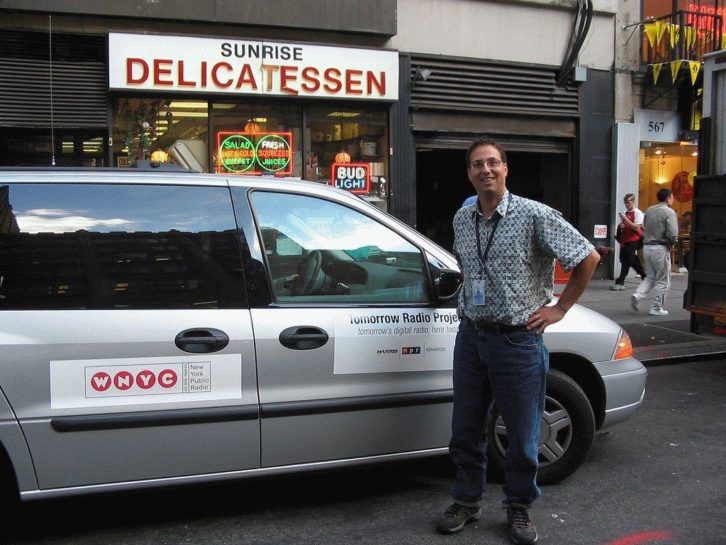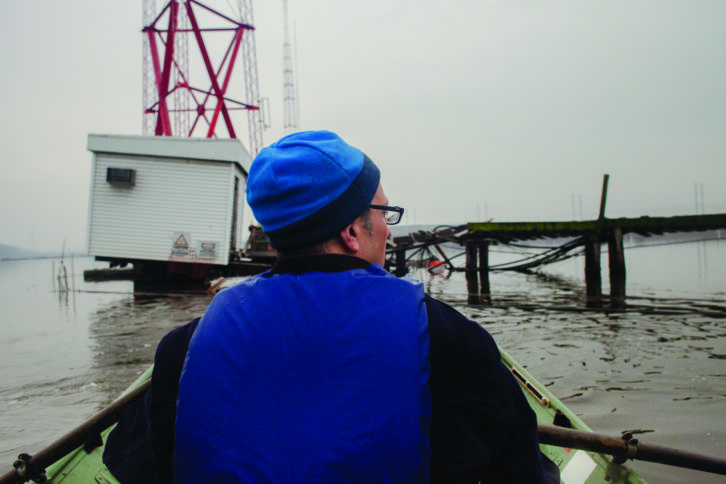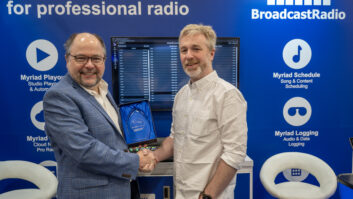Not too many people can brag about stashing a section of the original 1965 Alford master radio antenna from atop the Empire State Building in their office. For Steve Shultis, that piece of New York City broadcast history is a timeless keepsake.
“The heritage of broadcast in this city and the legacy of people like Andy Alford are very important to me,” he said.
“I have one of the 32 elements off the Alford antenna. It’s about 120 pounds. And this particular piece is very important to me since after 9/11 we plugged a 1 kW transmitter directly into the Alford master antenna system to keep WNYC(FM) on the air for months until we could build out a full-power site” at 4 Times Square.

Shultis, chief technology officer of New York Public Radio, is the recipient of the 19th annual Radio World Excellence in Engineering Award. The 35-year veteran of radio broadcast engineering is an integral part of New York Public Radio and the distribution of its innovative programming and content.
Recipients of the award represent the highest ideals of the radio broadcast engineering profession and reflect those ideals through contributions to the industry.
Shultis, 61, is responsible for all technology planning and oversight at New York Public Radio, including its state-of-the-art 85,000-square-foot broadcast studio, performance space and office facility. In addition, he oversees all business and broadcast IT platforms and network, broadcast engineering, telecom and MEP systems, Archive and asset management teams, A/V, podcasting and web streaming.
The organization’s broadcast portfolio includes two major FM stations in the city — classical WQXR and news/talk flagship WNYC — along with WNYC(AM) and four Class A FMs in New Jersey, which formerly comprised New Jersey Public Radio. It also operates WQXW(FM) in Westchester County, licensed to Ossining, N.Y.
Its broadcast complex in Soho in lower Manhattan occupies three floors of a 12-story building and includes The Jerome L. Greene Performance Space, a 6,000-square-foot live performance venue. The organization employs around 350 people, according to Shultis, including 70 in the newsroom.
“As knowledgeable as they come”
“Steve models forward-looking practices for how 21st century major-market radio stations look in today’s car dashboards,” said Paul McLane, editor in chief of the publication. “The organization is doing that through public-facing metadata and visual displays and integration of NYPR’s systems with HD Radio and the public radio MetaPub system. That’s just one reason we selected him for this award.”
Industry colleagues tout his vision for the digital future of radio.
“Steve is keeping NYPR on the cutting edge of radio broadcasting technology and he does his best to share what he learns and does at NYPR with the industry,” said David Layer, vice president, advanced engineering at the National Association of Broadcasters.
“Steve is as knowledgeable as they come in the broadcast engineering community, and on top of that he’s one of the nicest and friendliest people I know.”

Shultis grew up in upstate New York and got his first taste of audio as an apprentice for record producer Albert Grossman at Bearsville Records, located not far from Woodstock, N.Y. In high school he worked at the recording studio after school managing the tape library, which included stocking tape and supplies like razor blades and splicing tape.
“That was really something. Here is this famous jet-setter record producer, who worked with Bob Dylan and Janis Joplin, and he went through the local high school to find a student who might be interested in acoustics and audio recording to work for him. I think we can all learn from that. Here was a guy who gave a youth a chance at a vocation. It was really just dumb luck that I was right up the road from Bearsville Records.”
Shultis would sit in occasionally on sessions, including those by Peter Tosh. The popular reggae artist once recorded with Mick Jagger of the Rolling Stones at the studio as Shultis looked on.
“I was the unnamed assistant running cables and doing gopher jobs, but it was still very cool. I also met Todd Rundgren and the Isley Brothers.”
Shultis holds degrees in sound recording technology and music composition, so his focus on audio quality issues in broadcast radio is not surprising. His first job out of college was as a recording engineer in the music department at the University of California in San Diego and he even spent time as a plant mastering engineer for Sony Classical Recordings Inc.

In 1987, Shultis joined New York Public Radio. Today he oversees six technical teams with three dozen people reporting to him. The teams include broadcast engineering, facilities engineering, IT, broadcast applications and infrastructure, archives and streaming and on-demand architecture.
“And within IT we have two teams — one for business and one for broadcast — with two separate directors. We have the most creative technical problem solvers in radio. I firmly believe that.”
Those teams were critical for innovative implementation of technologies during the pandemic, including building a farm system of home studios to support the staff of its stations. “Honestly, the only reason for this award and this interview is because of the technical team we have here,” he said.
Shultis, who reports to NYPR CFO Armando Gutierrez, says most of his major projects at the organization have morphed out of a business need. “Maybe that is a simplification. I’m a technologist and I love to play with technology. But you have to be able to pivot to what works best for the business. And have the vision and be flexible enough to adapt quickly.”
Audio quality of the organization’s stations is a top priority for Shultis, who says it’s imperative a radio station sound good to be competitive in New York City whether a commercial or noncom station.
“I am kind of biased by being in New York. Market Number 1’s engineers all run a pretty tight ship. We are all peers and listen to each other and push each other. If you want to get better you want to compete against the best. We have the best of everything in New York City. It really promotes sharper skills and innovation.”

Lots of bytes
Shultis has long advocated for podcasting and streaming as critically important radio media channels that need nurturing. Not long ago Shultis calculated that New York Public Radio was delivering a petabyte and a half (a petabyte is more than a million gigabytes) of digital content via podcasts and streams each month.
“And you have to be willing pay for it. Unlike broadcast radio where your expenses are generally locked in whether one person or a million people are listening. But if you are getting like 20 or 30 million audio downloads a month and you are delivering that much data through the ISPs, you have to pay for every byte. You need a lot of sponsorship to do that,” he said.
Part of building a digital future for radio means maintaining relevance in connected cars, Shultis says, with a focus on how radio looks via visual content and published metadata.
His organization is hyper-focused on public-facing metadata and visual displays and integration of NYPR’s systems with HD Radio. It is testing Rapid software from HD Radio developer Xperi, which automatically collects visual content and publishes it on digital radio platforms, terrestrial FM, online and mobile.
“It is obviously critically important for radio to look good in the modern dashboard with consistent metadata. When you tune to WNYC, not only will you see all the metadata there but also eventually the Top 10 podcasts on WNYC to take advantage of the connected car,” he said. “I want to see a world where linear broadcasts push people to the non-linear products like podcasts and vice-versa.”
Shultis says he has a close relationship with Xperi engineers, and his stations have been at the forefront of recent developments to allow HD Radio stations to boost power levels. Several field tests using WNYC(FM) were conducted under FCC experimental authority last year and used by NAB and Xperi to develop a higher-power formula for FM HD channels to improve coverage without creating interference. The FCC is collecting comments on the proposal.
A recent ambitious project is the organization’s new digital asset management system, Shultis says, which is a repository that is searchable and recoverable for internal staff. It is about to launch, administered by a small, focused team.
“We have audio in there from 1937. It includes a huge number of valuable assets. We used to have silos of storage but had nothing that tied the whole company together. This unifies all assets, including production, taxonomy and marketing and legal and broadcast, in a single system,” he said.
Eventually the library could be made available to the public and to researchers and be used as a revenue-generating tool for the organization, he says.
Crisis memory
WNYC was one of the orphaned FMs in the attack on the World Trade Center on 9/11, its transmission plant destroyed in the fall of the towers. It’s a day Shultis will never forget.
“Our studios at the time of 9/11 were in lower Manhattan, about five blocks from the World Trade towers. Of course we immediately lost WNYC(FM), housed with the other FMs on Tower 1, but we also lost the microwave STL to WNYC(AM) that was located on the tower. We restored that quickly using our backup leased land lines. But when the towers were hit, our building management issued an evacuation order.
“It was a milestone event for sure. One thing I do recall is the generosity of both the late John Lyons at 4 Times Square, and the entire Empire State Building Master FM committee, who bent over backwards to help us restore using space in their transmitter rooms and the combiner room.”

Shultis says one career highlight has been serving with several broadcast industry support groups, including the National Radio Systems Committee. Shultis chairs the Data Services and Metadata subcommittee.
“The thought that I’m a chair still blows me away. I’m incredibly proud of my peers for the important work they have accomplished and are accomplishing for the radio industry,” he said.
In addition, Shultis is on the NAB Radio Technology Committee and working with Cox Media Group’s Roz Clark within the RTC’s Next-Generation Architecture working group, which is looking at the future of the entire radio STL chain.
“Bonneville’s Jason Ornellas has been leading a sub-group focused on a next-gen virtualized platform for Nielsen, and I have been doing the same for EAS, basically articulating the benefits and needs for a modern platform for these two important pieces of the broadcast chain, for which the EAS part is now the very last component of the broadcast chain that is not yet virtualized and solely dependent upon hardware,” Shultis said.
The organization is also a sustaining member of the Audio Engineering Society and typically sends upwards of a dozen or more staff to its annual conference in New York, he said.
“Since we have many team members who are involved both in remote audio production — live concert hall and other local venue broadcast and recording — as well as daily in-house live music production and broadcasting and the more typical radio newsroom engineering work, many of our engineers strongly gravitate and depend upon the Audio Engineering Society for peer papers, research and presentations and open dialogue with manufacturers that all works to further their craft.”
Through his more than 35 years leading the technologies and infrastructures that support New York Public Radio and its innovative programming and content, Shultis says the humans stand out the most.
“The people here have been amazing. I must say the passion runs deep, especially for those at WNYC. This has really been my only job, so it’s all I know. But we all go the extra mile to make sure the stations sound their best. We are all perfectionists with a passion and put in long days. And many of my co-workers are people I started with 35 years ago. It’s amazing.”
Shultis and his family live north of New York, a 70-mile scenic train ride running along the Hudson River. He raises ducks and chickens on his small farm and hopes to raise Nubian goats someday.
EXCELLENCE HONOR ROLL
2004 Andy Andreson
2005 Mike Starling
2006 John Lyons
2007 Clay Freinwald
2008 Jeff Littlejohn
2009 Gary Kline
2010 Milford Smith
2011 Barry Thomas
2012 Paul Brenner
2013 Marty Garrison
2014 Wayne Pecena
2015 David H. Layer
2016–17 Michael Cooney
2017–18 Larry Wilkins
2018–19 Russ Mundschenk
2019–20 Dave Kolesar
2020–21 Jason Ornellas
2021–22 Roz Clark
2023 Steve Shultis







